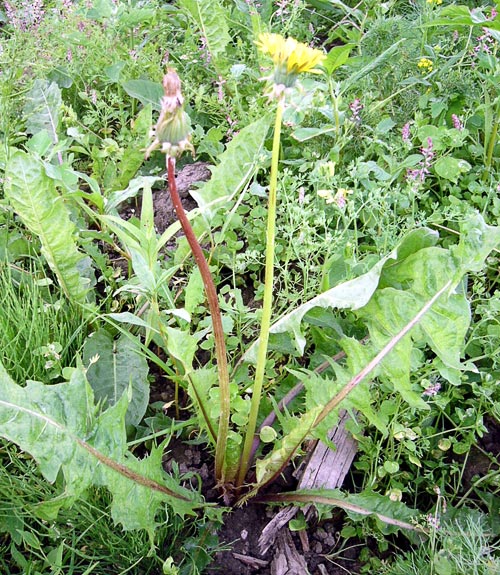Weeds
Taraxacum officinale Wigg. - Dandelion (blow ball).
Taxonomy.
Family Asteraceae Dumort. (Compositae), genus Taraxacum Wigg. Genus Taraxacum is complex, difficult taxon: too many apomictic species are described.Biological group.
core-root, perennial, hemicryptophyt.Morphology and biology.
Root is thick, vertical, seldom branchy; neck of the root is woolly, seldom naked. The root system is capable of growing deep into ground, up to 130 sm. Parts of the main root will create roots and grow. Leaves have spiral leaf-arrangement, in rosette, length 10-25 cm and width 2-5 cm, lanceolate or oblong, runcinate incised, from the entire irregular-dentate leaves up to the deep-pinnatipartite leaves with narrow lateral shares, from above sometimes naked, from below more often pubescent. The flower has a hollow stalk, pubescent under calathide head, height 5-50 cm. The calathide head: 30-70 mm in diameter. The spathe is 12-25 mm in length. Its external leaflets are green, from ovate-lanceolate to linear, already in the beginning of flowering strongly rejected aside and then bent downwards, always without cornicles. The florets are yellow, ligulate, internal and tubular. Fruit: the achene (seed) with a pappus-cop (6-10 mm) with simple white hair on a long thin leg. The achene (seed) is light-brown, length 3-4 mm, width 1.2 - 1.5 mm, thickness 0.7 - 1 mm. The form of the seed is cunniform, squeezed tetrahedral, wrinkled, ribbed, the upper part with sharp spines. Weight of 1000 seeds 0.2 - 0.8 g. Spring flowering of dandelion occurs from March (Central Asia) or May (Northern Europe) until July, and autumn flowering in August or in September. The plant reproduces by seeds and seldom vegetatively. One plant can produce 250-7000 seeds. Seeds are distributed by wind. The shoots of dandelion appear in the spring and in autumn. Autumn shoots survive the winter. The minimum temperature of germination of seeds is +2-4 degrees C. Shoots naked, epicotyl is not advanced, cotyledons widely elliptic (4-8 mm in length and 3-6 mm in width). In the first year the dandelion shows only the rosette of leaves and a tap root which on an adult plant can go down to 50 cm deep. In the second year the dandelion produces blossoming stalks. On old plants the upper part of the root creates short shoots (vegetative runaways) which can generate new plants. All parts of the root of a dandelion are able to grow and produce young growth (vegetative shoots). All this makes a dandelion one of the most annoying weeds, especially for vegetables, commercial crops, in gardens and parks.Distribution.
Taraxacum officinale is distributed in Europe and most of Asia. It is an adventitious plant in Northern and South America, Australia, Southern Africa. In the former USSR the dandelion is widely distributed in the European part, on Caucasus, in Western Siberia, Central Asia. The dandelion is found occasionally among quality adventitious plants in the Far East and in Eastern Siberia.Ecology.
The dandelion settles usually in places with broken vegetation. Thickets (young growths) frequently forms from the plant in garbage places and anthropogenous meadows. In natural meadows the dandelion is rare, and is found only in valleys of rivers. The dandelion is rather plentiful at humidities from dry steppe up to crude meadow; on rather poor, rich and saline soils. Anthropogenous actions (from hay-making to pasture grazing) are favorable to the dandelion.Economic value.
Widespread weed of gardens, parks and lawns, and also of vegetable and commercial crops. It infests long-term crops of (perennial) grasses and winter grain crops in abundance up to 3 points (on Maltsev's five-point scale) in the zone of southern taiga. It infests crops in the zone of northern taiga less. Control measures include: use the correct crop rotation, destroying weeds with the help of weeding or herbicides is important.Reference citations:
Bobrov, E.G. & N.N. Zvelev. 1964. Flora of the USSR. Moscow-Leningrad: AN SSSR. V. 29: 798.Fisyunov A.V. 1984. Weeds. Moscow: Kolos. 320 p.
Maevsky P.F. 1954. Flora of an average strip of the European part of the USSR. Moscow-Leningrad: Selkhozgisz. 912 p.
Maltsev A.I. 1937. Atlas of the major species of weed plants of the USSR. Moscow-Leningrad: Selkhozgiz. V. 1: 168.
Nikitin V.V. 1983. Weed plants of the USSR Flora. Leningrad: Nauka. 454 p.
Ramenskij L.G., Tsatsenkin I.A., Chizhikov O.N., Antipin N.A. 1956. Ecological evaluation of the fodder lands by vegetation cover. Moscow: Selkhozgiz. 472 p.
Shlyakova E.V. 1982. Keys to weed-field plants of the Non-chernozem zone. Leningrad: Kolos. 208 p.


